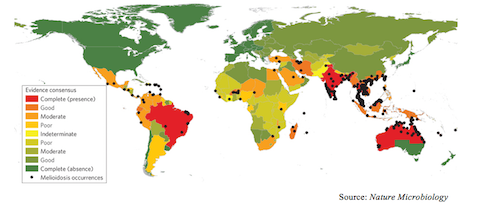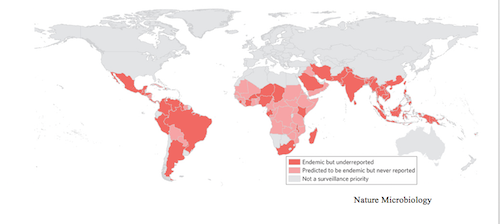Article
9 Things to Know About Melioidosis
Author(s):
While pharmacists don't often see cases of melioidosis, the disease is worth noting because of its high death rate.
While pharmacists don’t often see cases of melioidosis, the disease is worth noting because of its high death rate.
Besides being hard to diagnose, melioidosis is resistant to many antimicrobials, and fatality rates may exceed 70% when patients are treated with ineffective agents.
Depending on the type of infection, patients with melioidosis may experience pain or swelling at the infection site, fever, cough, chest pain, high fever, headache, anorexia, joint pain, disorientation, and respiratory stress, according to the US Centers for Disease Control and Prevention (CDC).
The CDC cautioned health care professionals that the infection can result in a wide range of symptoms, and it may be incorrectly diagnosed as tuberculosis or pneumonia.
The bacterium that causes melioidosis, Burkholderia pseudomallei, is often found in soil in Southeast Asia and Northern Australia, but it can be transmitted through skin inoculation, inhalation during extreme weather events, and ingestion of contaminated water.
Results of a new study of the disease estimate that there are around 165,000 human melioidosis cases per year, and about 89,000 of infected individuals die from it.
Pharmacists should pay particular attention to travelers who visit parts of South America, India, and Australia. The study authors also noted that melioidosis might not be recognized in some countries based on a lack of microbiological facilities or clinical and laboratory expertise, or inadequate reporting systems.

Here are 9 things pharmacists should know about melioidosis:
1. Researchers suspect that melioidosis is underreported in 45 countries where the disease is known to be endemic, and it could also be endemic in 34 more countries that have not reported it.
- Developed countries are seeing higher incidence of melioidosis because of travelers.
2. There is no vaccine for melioidosis.
3. Patients who have diabetes or chronic kidney disease and those who drink excessive amounts of alcohol face a higher risk for melioidosis.
4. The bacterium behind melioidosis spread from one facility to another at a primate research center in Louisiana in 2014.
- The CDC discovered that melioidosis spread from a facility where mice were being experimentally infected to the area where the primates were kept. The study authors noted that the contamination could have been made via the staff’s “inner garments.”
5. The researchers predicted that several geographic areas in the United States could become areas where B. pseudomallei could grow.
- Besides Louisiana, Texas and southern parts of Florida could be suitable settings for the bacterium. This is because these areas may have some similar environmental characteristics as the Caribbean and Taiwan.
- The researchers tested the B. pseudomallei suitability level in Louisiana in particular detail. They found that the suitability level at the primate center was very low, but it was moderately high in New Orleans.
- The study authors also pointed out it is possible that the bacterium already exists in the environment in the United States.
6. The tropics are especially hit hard by the bacterium due to large amount of rainfall, high temperatures, and anthrosol and acrisol soil. High salinity and large amounts of gravel are often linked with the presence of B. pseudomallei, as well.
- Danger zones would be Southeast and South Asia, tropical Australia, Western sub-Saharan Africa, and South America.
7. Almost 100% of all deaths associated with melioidosis happen in low- or middle-income countries.Fatalities in higher-income countries tend to occur in Australia, Brunei Darussalam, and Singapore.
- Fatalities in higher-income countries tend to occur in Australia, Brunei Darussalam, and Singapore.
8. The mortality rate for melioidosis is comparable with measles and higher than both leptospirosis and dengue infection.
9. Researchers identified the following highlighted countries as a priority for developing improved ways of preventing, diagnosing, and treating patients with melioidosis.

The growth in melioidosis cases should persuade public health officials and policymakers to focus more concerted efforts on combating the disease, the researchers argued.
“The global burden of melioidosis is likely to be substantial and increasing due to population and pathogen movements increasing the likelihood of establishment in new areas, fueled by an increase in anthrosol and the marked rise in the prevalence of diabetes mellitus globally,” they concluded.
Their study was published in Nature Microbiology.






